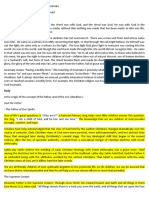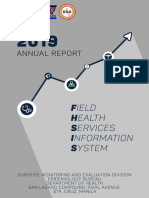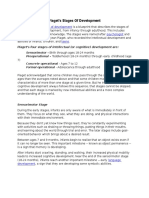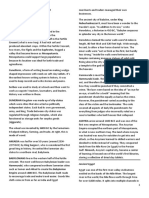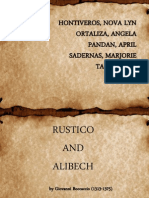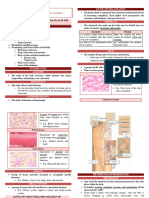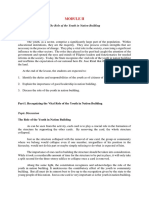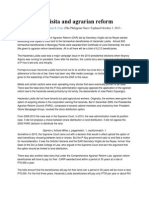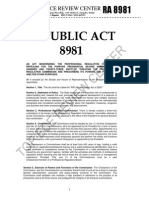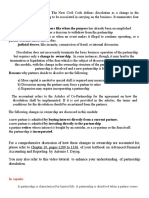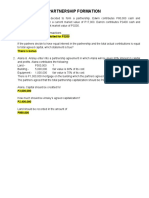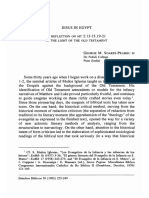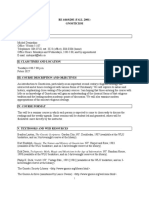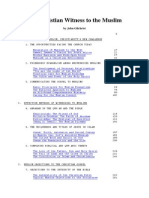Responding To The Call of Justice and Love
Responding To The Call of Justice and Love
Uploaded by
Von Andrei MedinaCopyright:
Available Formats
Responding To The Call of Justice and Love
Responding To The Call of Justice and Love
Uploaded by
Von Andrei MedinaOriginal Description:
Original Title
Copyright
Available Formats
Share this document
Did you find this document useful?
Is this content inappropriate?
Copyright:
Available Formats
Responding To The Call of Justice and Love
Responding To The Call of Justice and Love
Uploaded by
Von Andrei MedinaCopyright:
Available Formats
1
Introduction
God freely and lovingly created the whole universe
according to His Divine plan and it is His will to continue
guiding the whole of creation to its fulfillment. This Divine plan
is also understood as the Divine Law that governs and sustains
all created beings. It is also according to His plan that He
created us human beings and endowed us with knowledge and
free will to be able to understand, appreciate and participate in
His plan as co-creators and stewards of His creation. Thus, as
His co-creators, it is part of our responsibilities to live and act
according to His will for the world.
God’s work of creation is a continuing process. It is not
yet finished for He continuously creates and sustains every
being’s existence. The book of Wisdom highlights it when it is
written: “how could a thing remain, unless you willed it or be
preserved, had it not been called forth by you?” (Wisdom 11:25).
He is not only the creator of all that existed and are existing, but
also of those that are still to exist for He is the one who “calls
into being what does not exist” (Romans 4:17). As God’s co-
creators, created in His image and likeness (cf. Gen. 1:26), we
have the responsibility to be mindful of the purpose of this
ongoing creative activity and help in its realization. The
document Gaudium et Spes (GS) further states that we have the
responsibility to “govern the world with justice and holiness”
(GS, 34). The Catechism for Filipino Catholics (CFC) likewise
teaches that human beings are given the responsibility to be the
“organizing force” (CFC, 339) of creation. This involves not
only caring for the earth but more importantly, the
responsibility to commit to the promotion of “solidarity”
which is understood as the “firm and persevering
determination to commit oneself to the common good, i.e., the
good of all and of each individual, because we are really
responsible for all” (CFC, 341; PCP II, 295; cf. SRS, 38).
We are called to exercise responsible
STEWARDSHIP over all creation. Such a
Responding to the Call of Justice and Love
2
stewardship is exercised in our daily activities which
we can rightfully consider as a prolongation of
God’s continuing work of creating, and a service to
our fellow men and women. One sign of “living
Faith” is that we realize God’s graceful, supporting
presence in all our good thoughts, words, and deeds
(CFC, 341).
This stewardship for the common good is rooted on the
reality that God created us out of His eternal love for us (CCC,
356). It is because of this love that He intends the continuing
creation to move forward according to His eternal plan which
involves not only the good of the individual human person but
of the whole society for “the human person deserves to be
Responding to the Call of Justice and Love
3
saved and the human society deserves to be renewed”(GS, 3).
Every person needs to be part of a society for it is only through
living and dialoguing with fellow human beings that a human
person attains full development. The Church teaches that “the
human person needs to live in society. Society is not for him an
extraneous addition but a requirement of his nature. Through
the exchange with others, mutual service and dialogue with his
brethren, man develops his potential; he thus responds to his
vocation” (CCC, 1879). The importance of society in the full
development of the human person entails an important basis on
the significance of the social mission of the Church and
consequently, the existence of the social teaching of the Catholic
Church.
A “renewed” society that the Church envisions may be
described as a society whose members possess the following
characteristics:
1. Alive and life-giving. It is not enough that one can do his
daily chores and live a “normal” life. One cannot be
simply “living.” Every person must be alive, and to be
alive is not equal to simply having bodily functions. It
means being “aware” of what is happening around us.
An aware person not only knows what is happening
around him. He also knows the reason why they
happen and if possible, how they happen. An alive
person is life-giving. He reaches out to others and
becomes the source of their “awareness” and life.
2. Free and freeing. We dream of a community whose free
members are not only free individuals but are
themselves instruments so that others will also become
free.
3. Responsive and responsible. A responsive person responds
to the call of the signs of the times. He is not only aware
of the problems around him but he tries to be a part of
the solution to those problems. In every moment in our
life, we have a “calling” or an invitation. A student, for
example, inside the room has the “calling” to listen,
study and participate in the discussions. The student’s
response to this calling could either be a responsible or
an irresponsible one. In the macro level, the society has a
Responding to the Call of Justice and Love
4
particular calling or demand from each of its members
and from God to which it should make a responsible
response.
4. Loving and lovable. It is our dream that Filipinos become
more serious in their effort to love their neighbors as a
way of following the commandment of Christ. But not
only that. We should also make ourselves lovable, i.e. to
make it easier for other people to accept us and love us.
5. Caring and community minded. Caring for one another and
for the whole community is a very important aspect of
the Church’s vision of a whole community of faith. This
is needed in our communities particularly because of the
Filipino mentality of “close family ties” which causes the
tendency to limit our attention to our family members
only. This is sometimes called the sakop-orientedness of
the Filipinos. We often care only for those who belong to
our sakop, or territory or those under our power and
control.
The Church also envisions a community that speaks and
listens to all its members; a community that discerns and
decides together for the good of the community and implements
its decisions; a community that prays and celebrates their joys
and sorrows together; and a community that honestly evaluates
what they had done and failed to do. It is a community where
wealth is used for sharing, power is exercised for service and
values creates solidarity.
The Second Plenary Council of the Philippines (1991)
summarizes this vision of a people as makatao, makabayan, and
maka-Diyos. To these three, we may add another characteristic
which is maka-kalikasan.
Responding to the Call of Justice and Love
5
Chapter 1
The Social Mission of the Church
The mission
of the Church is the
proclamation of the
Gospel to the whole
of humanity. It is
centered on Jesus
Christ as the Good
News and His
Kingdom (Mk.
1:14). It involves
proclaiming Jesus
Christ as the savior Picture Courtesy of Ed Panulin
and liberator who offers salvation to all. This is the essence of
evangelization. In the document Evangelii Nuntiandi, (EN) Pope
Paul VI describes evangelization as “bringing the Good News
into all the strata of humanity, and through its influence
transforming humanity from within and making it new . . .”
(EN, 18). Integral evangelization “comprises the proclamation
of the Word, the communication of divine life through the
Sacraments, and the prophetic manifestations – through
Christian praxis – that the Kingdom of God has already begun
(Gomez, 1988, p. 26). St. John
Evangelization includes a two- Paul II describes three different
fold dimension: the religious situations for evangelization in
dimension and the social his encyclical Redemptoris Mission
dimension. (RM) namely, mission ad gentes
(to the nations), evangelization in
Christian communities, and the new evangelization. Mission ad
gentes is the evangelization in situations where “Christ and his
Gospel are not known”. Evangelization in Christian
Responding to the Call of Justice and Love
6
communities refers to the ongoing evangelization of those who
remain “fervent in faith”. New evangelization refers to a situation
between the first two descriptions. It is evangelization in a
situation where “entire groups of the baptized have lost a living
sense of the faith, or even no longer consider themselves
members of the Church, and live a life far removed from Christ
and his Gospel.” New evangelization is therefore, a kind of re-
evangelization of people.
Evangelization The Church's social doctrine is an
includes a two-fold integral part of her evangelizing
dimension: the religious ministry. Nothing that concerns the
dimension and the social community of men and women —
dimension (Gomez, 1988). situations and problems regarding
The religious dimension justice, freedom, development,
is manifested specifically relations between peoples, peace — is
in religious activities foreign to evangelization, and
such as the proclamation evangelization would be incomplete if
of the Word of God,
it did not take into account the mutual
Bible studies, celebration
demands continually made by the
of the sacraments, and
Gospel and by the concrete, personal
other liturgical activities.
and social life of man. (CSDC, 66)
The social (or socio-
political) dimension is “concretized in the promotion of integral
human development and liberation” which includes the
promotion of justice and charity. (Gomez, 1988) Actions for
justice and charity are considered “constitutive” (essential,
obligatory) element of evangelization. This is highlighted in the
Church document “Justice in the World” (JW): “Action on
behalf of justice and participation in the transformation of the
world fully appear to us as a constitutive dimension of the
preaching of the Gospel” (JW, 6).
Thus, evangelization or the proclamation of God’s
Kingdom to the whole humanity includes not only religious
activities but necessarily includes socio-political activities that
promote justice, charity, and peace. The Church further teaches
that
Responding to the Call of Justice and Love
7
This is evangelization: the proclamation, above all,
of salvation from sin; the liberation from everything
oppressive to man; the development of man in all his
dimensions, personal and communitarian; and
ultimately, the renewal of society in all its strata
through the interplay of the Gospel truths and man’s
concrete total life. This is our task. This is our
mission. (PCPII, 166)
The mission of the Church to the society is, therefore,
rooted in the second dimension (socio-political dimension) of
evangelization. It can be described as the mission to bring
about social transformation. It is the Church’s mission to help
make justice and love present in our society for the redemption
of the total person, that is, all the aspects of human life, be it
socio-political, economic, cultural or spiritual, from all forms of
oppression.
Just like the mission of Jesus, the Church's social mission
is three-fold: Kingly, Priestly, and Prophetic.
Jesus Christ
Three-fold Mission of Jesus
Kingly Priestly Prophetic
(Service) (Prayer/Worship) (Proclamation)
Towards a Towards peace founded
Towards integral on truth, built according
human deeper to justice, integrated by
development relationship with charity, practiced in
freedom
God
Mission of Every Christian
(Priestly, Kingly, Prophetic)
Responding to the Call of Justice and Love
8
This gives the Church (i.e., all of us members of the
Church through the leadership of our religious leaders) not only
the duty to be missionaries who would lead people to God and
inspire them to have a deeper spiritual life but also the duty to
become instruments of justice, peace, and development here and
now. Peace here is to be understood as not simply an absence of
war but as the presence and reign of truth, justice, charity, and
freedom. Development, on the other hand, is integral human
development, i.e. encompassing all the strata of the human
existence, be it social, economic, political, cultural, and
environmental. Pope Francis further states that
The Church’s pastors, taking into account the
contributions of the different sciences, have the right to
offer opinions on all that affects people’s lives, since the
task of evangelization implies and demands the integral
promotion of each human being. It is no longer possible to
claim that religion should be restricted to the private
sphere and that it exists only to prepare souls for heaven .
. . . Consequently, no one can demand that religion should
be relegated to the inner sanctum of personal life, without
influence on societal and national life, without concern for
the soundness of civil institutions, without a right to offer
an opinion on events affecting society. (Evangelii Gaudium,
182 – 183)
The document “Justice in the World” teaches that the
Church has received from Christ her mission which entails the
right and duty to proclaim justice on the local, national and
international level, and to denounce instances of injustice when
the fundamental rights of a person and his very salvation
demands it (JW 18). The
Church, therefore, has a With her social teaching the
specific mission to the Church seeks to proclaim the
society – a social mission. Gospel and make it present in the
This mission is a complex network of social relations
constitutive dimension of (CSDC, 62).
the Church and interrelated with the Church’s religious mission.
Specifically, this mission gives the Church the duty and
authority to teach and interpret the message of the Gospel to the
present context and thereby guide and assist all people in the
Responding to the Call of Justice and Love
9
pursuit of their total salvation (or kaginahawahan, as many
Filipino theologians prefer to use the term kaginhawahan as the
more appropriate translation of the term salvation instead of
kaligtasan). Consequently, this understanding of the mission of
the Church necessitates an examination of the constantly
evolving problems that confront modern human beings both as
individuals and as social groups.
Gaudium et Spes
Just like Jesus Christ, we cannot speaks of the Church’s
remain neutral. We need to make mission and says that out
a choice. The expression of our of the religious mission of
faith must always be preferential, the Church comes a
never neutral. function, a light and an
energy which can serve to
structure the human community according to the Divine Law
(GS,42). Only by remaining loyal to this mission can we say that
we have continued the work begun by Christ. We cannot
remain neutral or remain deaf to the cry of those who are
victims of oppressions and injustices. As Christians we should
follow the example of Christ and stand for what is true and just
in all the aspects of human existence. Just like Jesus Christ,
we cannot be neutral. We need to make a choice. The
expression of our faith must always be preferential, never
neutral. And this faith can only be expressed and must be
expressed through our spiritual, social, economic, political,
and cultural involvement here and now.
A. Christian Understanding of Salvation
The social mission of the Church maybe further
understood as emanating from an understanding of the
salvation promised by Jesus Christ as “salvation of the total
person”. This Christian understanding of salvation as
“salvation of the total person” is something that we must
properly understand.
We have been taught that Christ became a human person
Responding to the Call of Justice and Love
10
and he dwelt among us to fulfill His mission to save us. But
what does “saving us” mean and how did He do that? How did
He save us? The immediate and most common answer is: Jesus
saved us by dying on the cross. Is this a correct answer? Yes.
But then again, it is only half correct. Although we may read in
1 John 4:10 that: “And this is love, not that we love God but that
he loved us and sent his Son to be the expiation for our sins”, to
believe that Jesus Christ became human just to “die for our sins”
is missing the whole point of incarnation.
In the life of Jesus, we To believe that Jesus Christ
can see that he was totally became human just to “die for
involved in the life-situations our sins” is missing the whole
of the people around him. He point of incarnation.
cured the sick, he fed the
hungry and he forgave sinners. He laughed with them and
cried with them.
Mk. 1:15 – He said, this is the time of
fulfillment; the kingdom of God is at hand.
Change your ways and believe the Good News.
Mt. 11:4-5 – Jesus said to them in reply,
Go and tell John what you hear and see: the
blind regain their sight, the lame walk, lepers are
cleansed, the deaf hear, the dead are raised, and
the poor have the good news proclaimed to them.
Mk. 2: 5, 11-12 – When Jesus saw the faith
of these people, he said to the paralytic, "My son,
your sins are forgiven . . . Rise, take up your mat
and go home." The man rose and, in the sight of
all these people, he took up his mat and went out.
All of them were astonished and praised God
saying, "We have never seen anything like this!"
Lk 4:16-21 – When Jesus came to Nazareth
where he had been brought up, he entered the
synagogue on the Sabbath as he usually did. He
Responding to the Call of Justice and Love
11
stood up to read and they handed him the book
of the prophet Isaiah. Jesus then unrolled the
scroll and found the place where it is written:
‘the Spirit of the Lord is upon me. He has
anointed me to bring good news to the poor, to
proclaim liberty to captives and to give new sight
to the blind; to free the oppressed and announce
the Lord’s year of mercy.’ Jesus then rolled up
the scroll, gave it to the attendant and sat down,
while the eyes of all in the synagogue were fixed
on him. Then he said to them, ‘Today these
prophetic words come true even as you listen.
Mt. 5:23-24 – So, if you are about to offer
your gift at the altar and you remember that your
brother has something against you, leave your
gift there in front of the altar, go at once and
make peace with your brother, and then come
back and offer your gift to God.
To say that Jesus’ act of
saving us entails only dying on
the cross is an incomplete
concept of His saving act. In
between his birth and his
death, Jesus lived a life evident
of his promised salvation.
Evidently, Jesus did not come
only for spiritual reason. He
did not say to the sick: “I have
come only for the salvation of
your soul. Pray so that when
you die, your soul will go to
heaven.” Nor did he say to the
hungry people: “Pray, when
you die, you’ll go to heaven.”
Instead he cured and fed them.
The whole life and works of
Jesus, therefore, is a concrete expression of his mission to save
Responding to the Call of Justice and Love
12
us. His mission is a mission for liberation and his ministry is a
liberating ministry. He liberates people from forms of evil and
oppression. This salvation that He offers - real, present, and
concrete - was the same salvation experienced by the Israelites
which led them to profess God as the God who saves them from
oppressions.
Exodus 3: 7-8 - But the Lord said, I have
witnessed the affliction of my people in Egypt and
have heard their cry of complaint against their slave
drivers, so I know well what they are suffering.
Therefore, I have come down to rescue them from
the hands of the Egyptians and lead them out of that
land into a good and spacious land, a land flowing
with milk and honey.
Exodus 6: 6-7 – I am the Lord, I will free you
from the forced labor of the Egyptians and will
deliver you from their slavery. I will rescue you by
my outstretched arm and with mighty acts of
judgment. I will take you as my own people, and
you shall have me as your God. You will know that
I, the Lord, am your God when I free you from the
labor of the Egyptians and bring you into the land
which I swore to give to Abraham, Isaac and Jacob.
Christ’s mission of bringing salvation to us does not,
therefore, entail only his dying on the cross but also proclaiming
that the Kingdom or Reign of God is here and to bring good
news to the poor, the beggars,
the slum dwellers; to proclaim God saves the total person not
release to captives and to only from sin but from all
human evils and oppressions.
victims of injustices; to bring
health to the blind, deaf, dumb,
sick; liberty to the oppressed and announcing the jubilee year of
the Lord (which is understood as restoration of land,
cancellation of debts and release of slaves-cf. Lev. 25). This was
the mission of Christ – the salvation he brought to us.
Responding to the Call of Justice and Love
13
But still, some people tend to believe that Jesus’ mission
was purely religious and that he did not involve himself in
economic, political and socio-cultural matters. For better clarity,
let us look into the Scripture and see how Jesus criticized the
religious people of his time (cf. Gonzales & Gutierrez, 1994 p. 3).
a) Jesus criticized cultic worship, divorced from love of
God and neighbor (Mt. 5:23-24).
b) Jesus criticized a legalistic understanding of the
relationship between God and man (Mk. 2:27; Mt.
21:13).
c) Jesus criticized the religious elite of his time – the
pharisees, doctors of the law, and priests who used
religion for their own selfish reasons. The strongest
words of Jesus were certainly directed to them (Mt.
23:23).
It is clear therefore, that Jesus’ mission is very much
relevant and related to the economic, political, social, and
cultural realities. He is offering a salvation that is concrete and
must be experienced by people “here and now”. It is not
simply the kind of salvation that promises freedom of the soul
from sin so that a person will
Jesus’ mission is very much experience eternal life with God
relevant and related to the after death. That is just one
economic, political, social, and aspect of that salvation. Jesus
cultural realities. He is offering said that he came “to bring good
a salvation that is concrete and
news to the poor, to proclaim
must be experienced by people
liberty to captives and to give
“here and now”.
new sight to the blind; to free
the oppressed and announce the Lord’s year of mercy” (Lk.
4:18). His promised salvation is not only spiritual but also a
concrete one. He wants us to experience God as a saving God in
the same way that the Israelites concretely experienced Him
when He saved them from misery and oppression in the hand of
the Pharaoh of Egypt. The Israelites professed that God saves
because He “saved” them from Egypt. He is a God who gives
salvation to a hungry person, a deprived person, an oppressed
person, an insecure person, a suffering person. God therefore,
Responding to the Call of Justice and Love
14
saves the total person not only from sin but from all human evils
and oppressions. The Old Testament prophets taught this same
idea of salvation when they preached God’s promise of
salvation from war, oppression, hunger, etc. for abundance,
security, new heart, peace and new paradise (cf. Is. 2:2-5; Amos
9:11-15; Exequiel 36:22-32; Is. 11:5-9). For them God offers a
salvation that is concrete and can be experienced here and now.
Likewise, Christ’s promised
We believe that the Church is God’s
salvation entails proclaiming sign and instrument of salvation.
that the Kingdom or Reign of As a consequence, the Church has
God is here; bringing good to proclaim the Gospel of salvation
news to the poor, the to the political community. If only
beggars, the slum dwellers; for the fact that politics has such a
proclaiming freedom to decisive influence on the total good
captives and to victims of of human beings (CBCP’s Pastoral
Exhortation on Philippine Politics).
injustices; bringing health to
the blind, deaf, dumb, sick;
liberty to oppressed and announcing the jubilee year of the Lord
(which is understood as restoration of land, cancellation of debts
and release of slaves (cf. Lev. 25).
Hence, salvation should not be too spiritualized. It is not
only a salvation of the soul from sin. It is the salvation of the
living person from oppressions. One should not remain on the
understanding of salvation as “salvation of the soul from sin”
only. This “spiritualized” idea of salvation is the reason why
some Christians tend to dichotomize their faith and their way
of life. They are devout Christians only during Sundays. They
attend the Eucharistic celebration and receive the sacraments
and that’s all. In their day to day life one will not see a trace of
being a Christian. As a result, religion becomes unrealistic and
over-spiritualized. It involves only the spiritual aspect of
human life and excludes efforts to bring the Christian identity
into all the strata of human life – economic, social, political and
even cultural. Thus, there are members of the Church who call
themselves Christians and yet do not see the relevance and
connection of their faith to their economic, social, political, and
cultural life.
Responding to the Call of Justice and Love
15
This idea of salvation as concrete is the very
foundation and reason for the existence of a body of teaching
in the Church that we now commonly call as social teaching of
the Church or STC. It is founded on a concept of salvation that
is more of Kaginhawahan rather than Kaligtasan. The term
kaginhawahan more accurately captures the idea of a salvation
that brings life, peace, joy, health, the Spirit of God in and
among human beings, resurrection, glory, and a reborn and
transformed cosmos.
In Evangelii Nuntiandi, Pope Paul VI speaks of this idea of
salvation as “liberation from everything that oppresses human
beings; but specially liberation from sin and the evil one; in the
joy of knowing God and being known by Him" (EN, 9). This
liberation in the framework of the Church’s specific mission
cannot be contained in the simple and restricted dimension of
economics, politics, social or cultural life; it must envisage the
whole person, in all aspects, right up to and including the
openness to the absolute, even the divine absolute (EN, 33).
The bishops of Latin America also speak of the same two
elements of salvation: “The first is liberation from all forms of
bondage from personal and social sin, and from everything that
tears apart the human individual and society . . . the second
element is liberation for progressive growth in being through
communion with God and other human beings: this reaches its
culmination in the perfect communion of heaven, where God is
all in all and weeping forever ceases” (Puebla Document 480-
483).
It may be concluded that this kind of salvation or
kaginhawahan is not only a salvation or liberation from something
but also it is a salvation for something new – a human life that is
open to God and to fellow human beings as expressed in their
relationship and in their collaboration in bringing about the
realization of the Kingdom of God here and now.
Responding to the Call of Justice and Love
16
B. The Spirituality of Social Transformation
The social mission of the Church to bring kaginhawahan
to the society demands a life-long process of social
transformation. Decades of Church social action apostolate and
social work by different organizations have helped improve our
social condition but still a great deal must be done.
The PCP II offers us suggestions on how to effectively
respond to the demand for social transformation. It teaches that
The most basic and effective response . . . come
[sic] only from the very depths of our being as
disciples of the Lord, in our attentiveness to the
Holy Spirit whose movements are also to be
discerned in the events and situations of our day,
in our following of Jesus, in our fidelity to his
Gospel of Justice and Love and thus, in our
spirituality (PCP II, 262).
The PCP II
suggests a way of life, a All Christians, their pastors
spirituality which may be included, are called to show
concern for the building of a better
labeled as "spirituality of
world. (Evangelii Gaudium, 183 )
social transformation" as
the means towards attaining the kind of community that we
envision.
Spirituality may be understood as the inspiration within a
person to live a particular way of life based on his beliefs or
religious conviction. It may also refer to a person's religious or
ethical values that serve as the foundation for his actions and
decisions. Christian spirituality, on the other hand is defined by
the CBCP as the "call to all the members of the Christian
community to live and think, to make judgments and always
discern in relation to God, in the light of the Gospel, and the
teaching of the Church." In other words, it is an expression of
our fidelity to Jesus' Gospel of Justice and Love. It demands a
"radical living of what we preach, a witnessing to the radical
demands of the Gospel" (PCP II, 282). PCP II (275-282) further
Responding to the Call of Justice and Love
17
describes Christian spirituality as a following of "Jesus-in-
mission" or journeying in the Spirit of Jesus. This kind of
spirituality as it is being lived out by the Filipinos may be
labeled as Filipino Christian spirituality.
Social transformation, on the other hand, may be described
as the effort to bring harmony or kaayusan (PCPII) in our society.
It is a process that seeks to heal and liberate the society from its
social problems and injustices and transform it into a more
humane society.
Hence, Christian
spirituality of social
transformation is a life-
long task of responding to
the challenge of Jesus'
Gospel of Justice and Love
by committing oneself to
the mission of adjusting the
social order to the "radical
demands" of the Christian
faith.
1. Elements of Spirituality of Social Transformation
PCP II (278-282) enumerates the following major elements
of the spirituality of social transformation:
a. Enduring and intimate commitment to Jesus
Commitment to Jesus entails following his example of
commitment to love not only those who love us but even our
enemies. An important characteristic of this love is its
preference for the poor and marginalized and the recognition of
Jesus' presence among them.
b. Seeking of the Kingdom of God
Spirituality of social transformation is characterized by
continuous effort to make justice present and eliminate the
different forms of oppression that hinder the realization of the
Kingdom of God in the society.
Responding to the Call of Justice and Love
18
c. Sharing the Good News joy
Jesus' Gospel is good news of hope that brings contentment
and joy to those who believe. It gives us the assurance that in
the end, goodness will
Christian spirituality of social
prevail over evil. It gives
transformation is a life-long task of
us the joy in the realization responding to the challenge of
that Jesus, the "God-with- Jesus' Gospel of Justice and Love
us" remains with us in the by committing oneself to the
midst of sadness and joy, mission of adjusting the social
laughter and tears, order to the "radical demands" of
victories and defeats. the Christian faith.
d. Heeding God's Word
To live the spirituality of social transformation is to discern
and follow the will of God as revealed in the Scriptures, in the
teaching of the Church and in the experience of the faithful
gathered together as a Church.
2. External Manifestation of Spirituality of Social
Transformation
Christian spirituality of social transformation (SST) may
also be called "Christian discipleship". Living out our Christian
faith in our society should necessarily entail a social dimension
that will eventually transform the society into a just and humane
society. The Gospel has
a social dimension. It is
impossible to be a real
disciple of Christ while
being at the same time
unmindful of the
injustices and
oppressions happening
in the society or worse
while being the cause of
injustices and
oppressions.
Externally, spirituality of social transformation is manifested in
two ways:
Responding to the Call of Justice and Love
19
a. Social Service
Social service is commonly understood as helping
someone in need. It is an action rooted in charity and
compassion with the intention of alleviating the misfortune and
suffering of another person. The corporal works of mercy
comprises the list of actions for social service though it is not
limited to it. Thus, social service is a response to the effects of a
social problem.
b. Social Action
Social action includes efforts to correct the social
structures and help solve the problems that perpetuate the need
for social service. Some call it social justice, action for justice or
Christian social praxis. It begins with an analysis of and
reflection on the human experience through the lens of the
Gospel and proceeds to finding and providing general
suggestions to solve the different social problems. Unlike social
service that responds to the effects of the problem, social action
responds to the cause of the social problem.
C. The Four Steps in the Cycle of Christian Social
Praxis
4 1 The Church, in her
Action Experience
effort to live out the
spirituality of social
transformation, suggests the
Prayer four-step cycle of Christian
social praxis (some call it
social action; pastoral action;
3
Theological
2 or action for justice). It is a
Social
Reflection Analysis four-step method that
follows the see-judge-act
tradition and develops into a
spiral movement – a cycle
that repeats the whole process and yet at the same time
develops from the previous one and moves forward. These four
Responding to the Call of Justice and Love
20
steps are: a. Experience b. Social Analysis c. Theological
Reflection d. Action.
1. Experience
Experience is the first step or moment in the cycle of
Christian social praxis. Here, we ask the questions: “What is
going on in our present context?” “Whose experience is being
considered?”; What is the experience all about?”; “What do the
people feel?” ; “How do they respond?” The word experience
here refers to all that contribute to our current situation as
Filipinos including but not limited to our economic, social,
political, religious, educational, and ecological contexts.
This step is the foundation of all Christian social praxis
and it calls into consciousness the experiences of individuals
and communities. To be a good Christian involves being aware
of the different social issues. Thus, for us Filipinos, it is
imperative that we become aware of what is going on in the
Philippine society and eventually in the whole world
particularly those that affect the life and well-being of people.
The recent advancements in broadcast and social media make
the dissemination of information a lot faster and easier.
However, they also brought about a new challenge: the
proliferation of fake news, false information, and historical
revisionism. Distorted, inaccurate or false information shared
through social media particularly those sent by people with
hidden agenda have the potentials to cause real problems.
a. The Filipino experience
Our way of life is very much influenced by our
geography. The Philippines is an archipelago of 7,641 islands
lying about 500 miles (805 km) off the southeast coast of Asia.
The northernmost island, Y’ami or Mavulis island is 65 miles
(105 km) from Taiwan and the southernmost, Saluag is only 40
miles (64 km.) east of Borneo. The islands are of volcanic origin,
with the larger ones crossed by mountain ranges. The highest
peak is Mt. Apo (9,692 ft) in Mindanao.
Unfortunately, our country is in a “disaster-prone area”
for two reasons:
Responding to the Call of Justice and Love
21
• it belongs to the “ring of fire,” an almost continuous
chain of volcanoes that surrounds the Pacific Ocean
plate that comprise 60% of the world’s active
volcanoes. The Philippines alone has 100 eruptive
centers, most active of which are Mayon, Taal,
Hibok-hibok, Bulusan and the most destructive in its
written history, the Mt. Pinatubo which erupted on
June 9, 1991.
• part of the Philippines, particularly the eastern part
in the Pacific Ocean is called “the cradle of
typhoons." This is why countless typhoons visit the
Philippines yearly.
Aside from
earthquakes, volcanic
eruptions, typhoons and
floods, we often
experience dry season
that brings another
devastation - drought.
The "El Niño"
phenomenon has been
recurring these past years
and has enormously
inflicted damages to the
whole Philippines not
only in the source of
water for many
Philippine cities but most
specially in the agriculture sector. In 2017, the United Nations
University’s Institute for Environment and Human Security has
released its 2017 World Risk Report, which indicates that the
Philippines ranks third on the list of countries with the greatest
exposure to natural disasters and third in the list of most
vulnerable countries. Vulnerability is measured based on “three
components: coping, or the country’s level of preparedness and
ability to respond effectively to disasters; adaptation, which is
the nation’s ability to adjust and form “long-term strategies” for
Responding to the Call of Justice and Love
22
climate change; and susceptibility, which measures the citizens’
socioeconomic conditions” (https://weltrisikobericht.de/
english-2/).
Conversely, our unique geography provides us with
plenty of natural resources. We have vast arable lands, long and
beautiful coastlines, abundant marine resources, and rich
mineral resources. However, despite all this richness, a big
number of Filipinos remain poor.
i. Economy.
In our country, the saying "the rich are getting richer and
the poor are getting poorer" remains true. Several studies report
that the problem of unequal distribution of wealth not only
persists but is even getting worse as the inequality between the
rich and the poor widens (Cigaral, 2017).
Majority of the Filipino families still depend on
agriculture. At present, agriculture is still one of our country's
major source of gross domestic product. Yet, the majority of our
country's poor belong to the agriculture sector. This is due to
the fact that most of our farmers do not own the farms they till.
Dominant families in our country own the majority of our
agricultural land. At least 52% of the farms in our country
remain under tenancy, lease, and other forms of tenurial
arrangements (Guzman, 2007). Other reasons are the lack of
government support to farmers, lack of training, lack of
infrastructures such as farm to market roads, drying facilities,
irrigation system, etc., and the proliferation of imported
agricultural products in the market. According to IBON
Foundation, “long-time government neglect and low
prioritization has put the agriculture sector in a chronic crisis
(IBON Media, 2019).
Presently, there are varying opinions on the definition of
“economically poor”. The Philippine Statistics Authority (PSA)
reported that in the first semester of 2018, 21.0% of the
population are poor which is equivalent to 23.1 million
Filipinos. This is however based on the poverty threshold of
Responding to the Call of Justice and Love
23
Php9,063.75 a month for a family of five, or Php60.43 per day
per person which many, including the IBON Foundation,
consider unrealistic, absurdly low and grossly underestimates
the number of poor families in the country (IBON Media, 2018).
But whether we accept the PSA poverty threshold or not, still it
can be said that at least 1 out of every 5 Filipinos is poor. The
number of poor Filipinos could be higher than that depending
on the poverty line being used.
ii. Environment
The relentless exploitation of our natural resources has
advanced at an alarming rate. Despite the increasing demand
to take care of our environment, burning of fossil fuels,
dynamite fishing, deforestation, mining, quarrying, and other
forms of environmentally destructive activities continue in
many parts of our country. The situation was made worse by
the construction of environmentally threatening energy projects,
the use of inappropriate technology to increase agricultural
production, and the
massive conversion of
agricultural lands into
industrial zones, golf
courses and subdivisions.
Indeed, our environment is
in a bad shape. Our air
and water are increasingly
becoming polluted.
Aside from all these environmental problems, we must
not forget the most threatening environmental issue we have to
face today – global warming. Global warming refers to the
increase in the average temperature of the earth's near-surface
air and ocean which is mainly caused by the increase in the level
of greenhouse gases in the atmosphere. Although the detailed
causes of global warming remain to be fully studied, there is a
scientific consensus that the present global warming is mainly
due to human activity.
The documentary film by ex-US Vice President Al Gore
Responding to the Call of Justice and Love
24
entitled “An Inconvenient Truth” opened the eyes of many
people around the world regarding global warming and the
imminent devastating effects it could bring.
iii. Education
In the
Philippines, poverty
and quality of
education are
usually interrelated.
Better educated
people have better
chances to improve
economically and in
the Philippines, poor
people have lesser
access to quality
education. Filipinos believe in the importance of good
education thus, the law of the land provides that the education
sector should receive the highest share in the national
government budget. Yet, the issue of education in our country
remains a gargantuan problem. Every start of school year, we
hear reports of lack of classrooms, lack of quality school facilities
and instructional materials, lack of student-teacher interaction
due to crowded classrooms, lack of teachers, low salary for
teachers, etc.
In 2013 the Department of Education initiated the K to 12
program which extended the basic education cycle from 10 to 12
years. This program aims to better equip Filipino students to
the challenges of a more globalized context, to improve quality
of education and help improve employability of graduates. The
two years were added to provide additional time for mastery of
different subject areas or training and expertise in specific skills
thus making the Filipino high school graduates not only
employable but also gain a competitive edge and better
recognition here and abroad. The implementation of this
program and its effects not only to the basic education system
but also to the Filipino families and to higher education
Responding to the Call of Justice and Love
25
institutions, were initially challenging. Six years after its
implementation there are still on-going debates on whether the
K-12 program actually helps the country’s educational system or
simply provides additional burdens to it.
Starting school year 2018-2019 Filipino students started
benefitting from Universal Access to Quality Tertiary Education
Act, a law providing free tuition for students of all state
universities and colleges. The bill was principally authored by
Sen. Paolo Benigno Aquino IV and signed into law by President
Rodrigo Duterte in 2017. This was a very positive development
in the educational system of our country. This law provides that
students enrolled in 112 state universities and colleges (SUCs),
78 local universities and colleges (LUCs), and all technical-
vocation education and training (TVET) programs registered
under the Technical Education and Skills Development
Authority (TESDA) will be free from tuition and other fees.
The Philippine educational system has a lot to improve
in many areas. One is in the area of policy such as a review of
the grading system to lessen the concept of education as
competition among students, increase in salary of teachers,
lessen teachers’ paper works, and measures to address alleged
issues of corruption. Another is in the area of pedagogy.
Teaching approaches must adapt to the new challenges of the
21st century learners and the demands of the 4th industrial
revolution. Related to this is the improvement in school
infrastructures not only on basic facilities but also on
information technologies that would make internet connectivity
and e-learning platforms available for teachers and students.
iv. Socio-cultural
The Philippines is rich in cultural heritage. If one will go
around the country, the richness and variety of traditions and
cultures are evident. From the different tribes in the mountains
of Mindanao, Visayas and Luzon to the “sea people” of
Mindanao and among the lowlanders, we can find different
cultures that have either remained or evolved after several
hundred years since the coming of the Spaniards.
Responding to the Call of Justice and Love
26
But over and above these different cultures, one can find
a generic Philippine culture. This is the culture recurring in all
the many cultures and subcultures within the Philippine soil.
The PCP II mentioned this fact and traced the roots on the
structuring of our many social and ethnic groups and the basic
values that go with that structuring. It does not matter whether
one is an uplander or lowlander, or a Christian or a Muslim,
educated or illiterate, as long as one is a Filipino, then the
structure of his social relationship is that which is based on the
family and its well-being which goes beyond contacts with
Muslim and Christian traditions.
Basic values (family, loyalty to family, concern for its
security, stress on authority, and respect for elders, among other
things) are supportive of this sociological fact. The
commonalities are more striking than the differences and we can
conclude there is indeed a common culture and a common social
structure that we can truthfully call Filipino (PCP II, 19).
Hiya, bahala na, pakikisama, pakiusap, utang na loob, close
family ties, are some of the Filipino values that are presently
considered “suspect for negative influences”. As they are, they
have their positive and negative sides. Let’s take for example
hiya. In itself, hiya is neither good nor bad. It helps a person to
be more sensitive and to be more prudent and circumspect. But
negatively, it has resulted in our greater concern for porma
“form” (dyaporm, paporma) rather than the substance, too much
concern on what other people would think or say, and the
refusal to oppose an authority or a friend (kasi nakakahiya).
Likewise, bahala na attitude makes a person too complacent and
take things for granted.
The close family ties, meanwhile, may lead to the negative
value of small group centeredness that hinders the nation’s
progress. This value is also touted as having perpetuated the
existence of political dynasties, family monopolies and
nepotism.
Responding to the Call of Justice and Love
27
Pakikisama, on the other hand, is often viewed as one of
the causes of graft and corruption in the Philippines. This is
made worse by the tayo-tayo and utang na loob mentality which
disregard the common good in favor of a person or a small
group because of the desire to repay personal indebtedness.
But we also have cultural values that we can be proud of
as they have strengthened us as a people. They are: paniniwala sa
Diyos, paggalang, pagdadamayan, and pakikipagkapwa-tao. If we
can only strengthen and harness these values within every
Filipino, then they can be important tools in the development of
our nation.
v. Politics
Politics is the art of governance and public service. It
should be exercised for the service and welfare of the people.
But here in the Philippines, authentic politics is visibly lacking.
We are proud of our democracy but sadly, the same system
leads us to inequality in social power. Politics now is reduced to
an arena where the interests of the powerful (and, as to be
expected, rich) are given more emphasis, to the detriment of the
poor and the weak. Our country is teeming with traditional
politicians (trapo) who use their public office as a means to
perpetuate their influence and power. Consequently, many of
our leaders today are either scion of wealthy families or heirs of
political dynasties.
The Philippine
Constitution describes public
office as a public trust meant for
the good of civil society.
Politics, therefore, in itself is
not dirty (contrary to what
most Filipinos think today).
Sadly, we have created a
political culture where power
and greed, not the intention to
serve based on one’s principles,
are the operative norms of
Responding to the Call of Justice and Love
28
conduct of many government officials.
Guns, goons and gold are ever present in the traditional
Philippine political culture. Private armies exist. Political
dynasties control territories. Almost throughout the
Philippines, we can hear “political families” whose great
grandfather was a mayor, the grandfather was the governor, the
father is the town mayor or the congressman and after his term,
his wife will run for the same office and then after the wife, the
son, and so on. Our 1987 Constitution prohibits political
dynasties (Art. 2, Sec. 26) but the enabling law necessary to
implement it is still pending in Congress. Several congressmen
acknowledged that such law will never be passed because
almost all congressmen are guilty of it and it goes against their
political interests.
Political elections in our country are always plagued
with massive killings, cheating and vote-buying. Despite the
efforts of some concerned groups like the National Movement
for Free Election (NAMFREL), Parish Pastoral Council for
Responsible Voting (PPCRV), Legal Network for Truthful
Elections (LENTE), and National Secretariat for Social Action
(NASSA), cases of cheating and other electoral frauds remain
unresolved.
Graft and corruption is also
another serious problem in our
country. Billions of pesos that could
have been channeled to
development projects for the poor
and increase the social services
provided are wasted in graft and
corruption in the government.
In a survey on corruption
conducted by SWS among Filipino
managers engaged mostly in
manufacturing, trade, finance,
transportation and communication businesses and other private
Responding to the Call of Justice and Love
29
services, respondents said that:
• Corruption in the public sector is worse than in the
private sector
• Most corrupt agencies are BIR, Customs, and DPWH
• Seventy-two percent were asked for a bribe
connected to taxes or licenses
• Thirty-five percent were asked for a bribe connected
to a transaction with government
• Most common government regulation activities
prone to bribe include: local government permits or
licenses, payment of income taxes and national
government permits or licenses.
• Fifty-seven percent reports that most or almost all
companies in their sector use bribes to get public
contracts
• Php2 Billion lost by government to corruption
annually according to COA.
• The most obvious negative impact of corruption is
that on the potential beneficiaries of public programs
or projects. By eating into the provisions for a
project, corruption either raises the cost to project
beneficiaries, or lowers the quality (or both
simultaneously) of a project" (Primer on Corruption,
2006).
In an article on corruption,
There are sins that by their Dr. Anna Marie Karaos, the
very nature constitute a Executive Director of J. J. Carroll
direct attack on one’s Institute on Church and Social
neighbor and give rise to Issues of the Ateneo de Manila
social structures,
University mentioned that according
institutions and situations
to recent studies, 65% of funds
that are contrary to the
allotted for textbooks for public
Divine goodness.
schools is usually reserved for
bribes, commissions on public works
reportedly run up to an average of 30% of the project cost, 12-
20% of pork barrel funds is pocketed by legislators, and
legislators get to keep for themselves as much as 45% of the
Responding to the Call of Justice and Love
30
allotted funds for the purchase of medicines, books and
instructional materials (Karaos, 2007).
Bishop Oscar V. Cruz (2007), the former President of the
CBCP and Archbishop of Lingayen-Dagupan, identified the
following costs of corruption to the Filipino people:
▪ Money cost. “According to the most conservative
estimate of the Commission on Audit, graft and
corruption in the Philippines cost a minimum of 2 to
3 Billion pesos a year to the people. It is a given that
the COA itself is sadly not altogether free of graft and
corruption.”
▪ Social cost. “The supposed beneficiaries who
constitute the Filipino people are robbed of what is
due them in social development. This translates to
socio-political instability and citizen’s discontent
brought about by poverty, hunger and sickness—not
to mention poor education, lack of medical and
welfare services.”
▪ Ethical cost. . “Most costly of all the ill-effects of
flagrant graft and blatant corruption are the hidden
ones of ethical nature and/or moral import— such as
the following: 1) Graft and corruption become a
political given. Acceptance of greed and consequent
deception in money matters become but a fact of life.
The pursuit of fast and easy money comes as a matter
of course. Honesty and integrity are only for the
simpletons and fools who know no better. 2)
Promotion of the culture of lying, cheating, and
stealing. Erosion of the fundamental values of
honesty and integrity. Deadening of conscience even
among young people—to the extent of their loss of
the sense of right and wrong, the distinction between
virtue and vice. 3) Indifference to the gross violation
of social justice, apathy to the oppression of the
common tao, resignation to the reality of easy life,
abuse and thievery among public officials. Adoption
of the “see nothing, hear nothing, say nothing”
stance as a rule of life to the extent that each one is
responsible only to oneself.”
Responding to the Call of Justice and Love
31
b. The Reality of Social Sin
Not a few good intentioned Filipinos are willing to give
their own share in solving the different problems of our country.
But no single individual or group of individuals can entirely
solve our national problem. We need the whole nation, or at
least the majority of our people, to realize the real cause of our
problems before we can solve it. The late Jaime Cardinal Sin, in
one of his homilies, identified the root of our problems and
called it "moral decay". This moral decay is manifested in the
sinful persistence of oppressive situations and structures in our
society. In other words, the real root of our problem is
structural. There are sinful situations and structures in our
country’s different systems that help perpetuate inequality,
oppression and injustice.
All sins, even those individual sins resulting from
personal act, in some way, affect others. There is no sin, not
even the most intimate and secret one, that exclusively affects
only the agent. The whole body of Christ (the Church) is
affected, in a greater or lesser way, by every sin that its members
commit. However, there are sins that by their very nature
constitute a direct attack on one’s neighbor and give rise to
social structures, institutions and situations that are contrary to
the Divine goodness (Catechism of the Catholic Church, 1869).
These structures are considered sinful because they are the root
causes of massive poverty, oppression and injustice and they
promote and perpetuate sinful attitude and behavior. These
situations and structures are called
social sins – which are further
grouped into sinful structures, sinful
situations, and sinful attitudes.
i. Sinful structures
Sinful structures are those that
step on the people's dignity and
prevent people from exercising their
rights. An example of this type of
social sin is the imposition of Martial
Law in the Philippines during the
Responding to the Call of Justice and Love
32
regime of Marcos when it was widely believed that almost all
agencies of the government were infected by graft and
corruption, cronyism and nepotism. Another example is the
colonial-style trade relations between the first world and the
third world where third world countries remain at the mercy of
first world countries as the latter dictates the terms and
conditions of their trade.
Another example is the debt Silence helps the oppressor
problem brought about by the not the oppressed. Neutrality
present global realities that have protects the offender never
become an institutionalized the offended.
global usury dominated by
international creditor nations, finance institutions and banks
that entrap debtor-nations into debt dependence that pushes
poor countries like ours into deeper debt problem. This was
made worse by our P.D. 1177 that automatically allocates a big
portion of our budget that should have been used for social
services, to pay our debt’s interest and only a small fraction of
the capital.
There are sinful
social structures when there
is habitual pattern of human
interactions infected by sin,
selfishness, injustice, pride,
greed, hatred. They
perpetuate disvalues. They
are inducements to sin and
are formidable obstacle to
Christian living (PCP II,
82).
ii. Sinful situations
Sinful situations lead
people to become greedy
and selfish. The “culture”
of graft and corruption that
exists in our country is a
good example of this. A
Responding to the Call of Justice and Love
33
friend, for example, always makes sure that a one-hundred peso
bill is inserted next to his driver’s license. His purpose is of
course to surreptitiously offer a bribe to the policeman if ever he
will be caught committing a traffic violation. He sees nothing
wrong in bribing a policeman because it is more expensive and
time consuming to claim back a confiscated license. Another
friend complains that, to land a job in a government office, what
is important is not what you know but who you know. Even in
some schools, it is not uncommon to meet a school head or
supervisor asking for a gift from a new teacher. And during
elections, vote-buying has become prevalent that people talk
about it openly. Years ago, a person who received money from
a candidate will never admit it in public. But today, many
voters even publicly ask for money from candidates or compare
among themselves which candidate “buys” with the highest
“price.” This vote buying is often seen as the root cause of many
problems in our society. Politicians who won through this
means will see to it that he gets back the money he spent before
his term ends. Drug-trafficking, illegal logging, the rising
number of the poor and unemployed, the justice system that
cannot convict big businessmen for their millions of pesos of
unpaid taxes while the poor ordinary citizens shoulder the
burden of the nation’s expenses, these are only some of the
examples of the second type of social sin.
iii. Sinful attitudes
Sinful attitudes are committed by those who allow or
directly participate in the evil committed against others. It also
involves the sin of omission because of the inaction of some
people to prevent evil from taking place. The conspiracy among
government officials who make use of their power to enrich
themselves; the Filipinos who close their eyes to the abuses of
greedy government officials whom they elected in exchange of
a small amount of money or on the basis of popularity; those
who do not care as long as their family is taken care of or
because of the mentality that nothing can be done anymore,
those people who buy stolen cellphones, cars, etc. because they
are sold at a much lower price, are just few examples of this
third type of social sin.
Responding to the Call of Justice and Love
34
The Catechism of the Catholic Church (#1868)
enumerates ways by which we become responsible for the sins
committed by people around us and by which we contribute to
the social sins in our society. They are:
• participating directly and voluntarily in them;
• ordering, advising, praising, or approving them;
• not disclosing or not hindering them when we have
an obligation to do so; and
• protecting evil-doers.
Poverty in the Philippines, for instance, is a result of
social sin. It is not caused by the lack of resources. Rather, it is
caused by the “gross unequal distribution of wealth.” Some
people have more than they need while the rest do not have
even the basic necessities of life. The wealthy are getting richer
at the expense of the great masses who get poorer every day.
But of course, the Church does not teach that being rich is in
itself sinful. It is never sinful to be born to a wealthy family.
However, being selfish and living a luxurious life in the midst of
people who die of poverty and hunger is an instance of sin. The
inequitable and unjust distribution of wealth should make the
rich realize that there is a connection between their lifestyle and
the poverty around them. This realization or social
consciousness should lead them to share what they have and
help solve the problem of poverty. Quoting St. Ambrose,
Populorum progressio states that:
You are not making a gift of your possessions to the poor
person. You are handing over to him what is his. For what
has been given in common for the use of all, you have
arrogated to yourself. The world is given to all, and not only
to the rich (Populorum Progresio, 23).
Solicitudo Rei Socialis has the following to say:
One of the greatest injustices of the contemporary world
consists precisely in this: that the ones who possess much
are relatively few and those who possess almost nothing are
Responding to the Call of Justice and Love
35
many. It is the injustice of the poor distribution of the goods
and services originally intended for all (Solicitudo Rei Socialis,
28).
Social sin marks our present world. As Christians, we
cannot just close our eyes to what is happening. PCP II states
that:
In the poverty and underdevelopment of our nation, in its
conflicts and divisions, we see the hand of human
sinfulness, particularly the grasping paws of greed for profit
and power. It is sinfulness that is at the root of our socio-
economic and political problems, and we need to name the
problems by their true name of sin. The Christian
conscience must recoil at the sins committed against the
poor . . . our inequity is a moral evil . . . there are indeed,
structures of sin or social sins which consist of situations,
collective behavior, or structures that cause and perpetuate
social injustices (PCP II 266, 267, 270).
c. Our sources of hope
In the words of the PCP II, though we have “shadows”,
we also have “lights”. Though we have problems and
challenges, we have reasons to be thankful and hopeful.
Not all is darkness for the Filipinos. Most Filipinos do
not lose hope. We can effect change. We have done it twice, in
EDSA 1 and EDSA 2. We can do it again if only we will hold on
to that spirit of unity and hope that inspired us to long for
change and a better Philippines.
Some of our sources of hope are the following:
i. Steady economic performance. Despite the many
problems that beset our country, we cannot deny that
our economy has somehow improved. This provides
hope for many Filipinos. Thanks to the agriculture
and export sectors and to the remittances coming
from the OFWs.
ii. The unwavering faith of the Filipino people. The
Filipinos are very religious people. The fire of faith
Responding to the Call of Justice and Love
36
that seems to have died in other western and
European nations is still burning in the hearts of
Filipinos and gives us the strength to move on. This
faith that has shaped our lives for centuries now has
become an important part of us. The Christian
virtues of forgiveness, unity, caring, and compassion
are very evident in everyday Filipino life in spite of
the so many bad news that saturate almost all forms
of media reports. More and more concerned
Christians are coming out to proclaim their faith and
live it out by becoming good influences to other
people. This is what PCP II calls the “solid base”
upon which we can build our society on. This is the
same faith that made EDSA Revolutions (both 1986
and 2001) possible and brought democracy back into
this land. The unwavering faith of the Filipinos is
further enhanced by greater involvement of the laity
in Church affairs and decision making. Thus, a real
community of faith is little by little, being realized in
many places in our country – a community where all
members feel that they are a part of the whole
community, a community where Christian values are
promoted and everyone’s worth, opinion and
contribution is counted.
iii. The increasing
social awareness
and concern for
social change and
development.
Today, Filipinos,
particularly the
youth sector, are
becoming more
aware of their
responsibility as
citizens. We see
increasing number of
Filipinos who are
Responding to the Call of Justice and Love
37
willing to take part not only in different social issues
and activities but also in decision making for the
good of their community. Though a lot remains to be
done, nevertheless, more and more Filipinos are
responding to the challenges of time.
iv. The commonalities that exist among different
cultures. Though we have a diverse cultural
heritage, we can still say that there is a common
culture that exists among Filipinos. It is a common
social structure or a leitmotif that runs through all
the different Filipino cultures so much so that it does
not matter whether we have different religions,
different traditions, or even educational and social
background. This is very important particularly in
our quest for peace and national unity. This could be
the ground on which we can bring our one nation
towards greater harmony and prosperity.
v. The growing number of NGOs (non-government
organizations) and POs (people’s organizations).
The NGOs and POs provide the needed support for
our ailing society from the grassroots. These
organizations are becoming the sources and catalysts
of change in our society. They provide the needed
support and enlightenment to the citizens that the
government may have overlooked or neglected.
They can also be likened to the watchful eyes that
watch over erring government officials. They can
also be the sources
and the training
grounds for future
leaders of our
country. The more
cause-oriented NGOs
and POs there are, the
more fortunate we are
and the more we have
something to hope
for.
Responding to the Call of Justice and Love
38
The Filipino experience in the two EDSA revolutions has
proven and sharpened the Filipino spirit. We have shown that
we can do great things. The lessons we have learned and the
democracy we have won will forever provide us the strength
that will fuel us to hurdle social barriers and remain vigilant
against those who try to abuse their power.
2. Social Analysis: Analyzing the signs of the times
After being conscious
of our experiences as a
community, the next step is to
analyze the causes and effects,
identify the people involved,
and delineate linkages in the
different social issues. Here,
the question being asked is
“What’s behind all this?” This
process is called social
analysis.
Social analysis maybe defined as “the effort to fully
understand a particular social situation". Social analysis serves as a
tool that permits us to understand the realities we are dealing
with.
Social analysis is an instrument of Christian reflection.
Pope Paul VI saw the relevance of analyzing the situation in a
particular society and reflecting on the experiences arising from
those situations in the light of Jesus’ message. In his social
document, Octagesima Adveniens (Call to Action) (1971), Pope
Paul VI wrote that
It is up to Christian communities to analyze with objectivity
the situation which is proper to their own country, to shed in
it the light of the Gospel’s unalterable words and to draw
principles or reflection, norms of judgment, and directives of
action from the social teaching of the Church (OA, 4).
Responding to the Call of Justice and Love
39
Even before this pronouncement by Pope Paul VI,
Gaudium et Spes has already recognized the indispensability of
social analysis in the Church’s efforts to bring the Good News to
the modern world. It is stated that the Church “must rely on
those who live in the world, are versed in different institutions
and specialties and grasp their innermost significance in the
eyes of both believers and unbelievers.” (GS, 44) PCP II shares
the same conviction when it states that
A thorough social analysis, structural and cultural, is to be
promoted more intensely in the process of building up
discerning communities of faith, precisely to the end that
their efforts at social transformation take into account hard
social realities and carried through from a genuine
perspective of faith (Art. 22, #1).
Social analysis
should also take into We must move forward. We
consideration both the must want to move forward. But
objective and subjective first let us ask why we must want
dimensions of reality. to do so at all (PCP II, 33).
The objective dimension
takes into consideration
the external structures such as various organizations and
institutions, while the subjective dimension includes consciousness,
values, ideologies, and attitudes of the members of the society.
Social analysis focuses on and investigates isolated
issues such as poverty, unemployment, inflation, environmental
problems, international relations, etc. It also studies the
different policies that address and affect these issues like job
training, free-trade, monetary control, charter change, foreign
debt, etc.
To be more comprehensive, social analysis has to be both
historical and structural. Historical analysis is an analysis in
terms of time. It is a study of the changes of a social system
through time. Structural analysis on the other hand, is an
analysis in terms of what is happening to a particular structure.
It provides a cross section of a system’s framework in a given
moment of time
Responding to the Call of Justice and Love
40
However, Social analysis has some limitations:
a. It is not designed to provide an immediate answer to the
question, “What do we do?” It is does not give us a step-
by-step solution to the problem.
b. It is simply like a diagnosis of a sickness. It does not
provide a cure. “It is the local people and not the
‘experts’ who are capable of studying their social
problems and offering concrete steps towards their
solution "(Gorospe, 1997, 10).
c. It is not being done for purely academic purposes but it
is for the service of justice. Social analysis, therefore,
should lead us to actions for justice.
d. It is not value-free. Social analysis does not adopt a
neutral approach, a purely “scientific and objective view
of reality". Values and biases usually affect the analyst's
work. (There is, therefore, a need to wrestle with our
own biases, commitments, and values in life.)
In our effort to examine the structures of society we have
to ask the questions why and how. Why are there so many poor
people? How did they become poor? Why are the rich
becoming richer? Only by asking such questions can we have a
broader picture of the economic, social, political, cultural, and
religious situations of our society – identifying those who hold
power and make decisions, those who are victims and are being
oppressed and those who just do not care about the events
around them. Social analysis also helps us see the linkages and
influences that operate in the social system. The Philippine
Situationer of PCP II (8-33) is a very good example of social
analysis in the light of Christian faith (see Appendix A).
3. Theological reflection: Reflecting on the signs of the
times
The third step is the theological reflection. At this
moment, the questions we ask ourselves are: “What is the role
of my faith regarding this issue?” and “What does my faith tell
me to do?” “What is my mission?” “What does the Church
teach about it?” Here, the analyzed experience is seen in the
Responding to the Call of Justice and Love
41
light of the living faith, scripture, Church social teaching and
tradition. It is not simply a reflection or deliberation on what
must be done. It is “theological” because the element of
Christian faith is added in the deliberation on what must be
done: “As a Christian, what must I do?"; "What does the Bible
and the teaching of the Church say about the problem?”; “Can I
identify some statements of the Church made by a pope, a
council or a group of bishops that can be applied to this
problem?”
Knowledge of the social teaching of the Church is
necessary in doing theological reflection. The teaching authority
of the Church (the magisterium) helps us reflect and guides us in
living out our Christian faith in the contemporary social context.
Yet, the Social Teaching of the Church (STC) is not a very
popular teaching. There are even writers who call it the “best
kept secret of the Church.” Not that the Catholic Church wants
to keep it a secret but because up to now, only a small
percentage of Catholics know about it and a lot of people are
even surprised to know that the Catholic Church has such
teachings. Some blame it on the very nature of the contents of
the STC which for some are too radical and demand changes in
the social structure.
That’s why until now,
STC remains unpopular
and unknown to many
Catholics and many of
those who know it do
not want to preach it
because they do not want
to “rock the boat” and be
branded as rebellious,
subversive, or anti-
government. They
would rather preach
what is more pleasant and more acceptable to majority of people
particularly to the rich and powerful. But that should not
always be the case. To embrace what is true and just demands
Responding to the Call of Justice and Love
42
courage, strength, and dedication even if it would mean going
against the existing social structure.
4. Pastoral Planning and Action
This step is the actual living out of one’s mission to God
and to the society. After analyzing the experience and reflecting
on it in the light of faith, the individual or the community makes
a plan of action.
Here, we ask the questions: “What can we as a group or
as individuals do about this problem?” “How can we best carry
out our Christian mission in our society?” “What resources do
we have to help us with our plan of action?” “What is the first
step we should take?”
This last step is the goal of the social teaching of the
Church, i.e. to lead us Christians to a life of involvement for
justice, love, unity, peace, and integrity of creation.
This action will bring about new experiences which in
turn need to be analyzed and reflected upon in the light of faith
and will consequently lead to another action and new
experiences. Thus, the cycle continues.
But it should not be forgotten that throughout the four
steps, prayer is an important element. A Christian should not
forget his prayer life. That is why all the steps should revolve
around prayer.
5. The Need for Conversion
Finally, the task of the Church essentially involves
leading the people to conversion (metanoia/change of heart).
Change of heart is indispensable in any genuine and lasting
social transformation. Just like the Apostles, each of us is being
called by Jesus to a change of heart. We can see an example of
this change of heart in the call of the disciples and the
conversion of Simon Peter in Lk. 5:1-11 which involves three
important elements: realization of one's sinfulness, a new and
deeper understanding, and a radical response.
Responding to the Call of Justice and Love
43
a. Realization of one's sinfulness. The new experience of
Peter in Luke 5:1-11 led him to a realization of his own
sinfulness. Christians of today should realize their own
sinfulness and unworthiness before the Lord. Christians have to
realize that sinfulness is the root cause of our social problems.
b. A new and deeper understanding. This involves seeing
the world in a new way which includes:
i. a more holistic and deeper understanding of the
problem of poverty and social injustice,
ii. the recognition of the reality and evil effects of
social sin that causes much of the pain in the world.
c. A radical response. It means a radical change in
lifestyle, vocation or way of life. This calls for two responses:
i. personal response – an introspection on one’s
attitudes, lifestyle, status, etc. and changing one’s
values and priorities;
ii. political response – becoming
an agent of social transformation.
The PCP II reminds us
also that this conversion and
social transformation is not just
one moment of definitive change.
It is a lifelong task, striving from
the less perfect to the ever more
perfect, from death to life, from
life to ever fuller life (PCP II,
275).
Scrutinizing the ‘signs of the times’ and seeking the
meaning of emerging history, while sharing the
aspirations and questionings of all those who want to
build a more human world, we have listened to the
Word of God that we might be converted to the
fulfilling of the divine plan for the salvation of the
world (Introdution to Justice in the World).
Responding to the Call of Justice and Love
44
Activity #1
Name __________________________________ Date_______
Course/Year/Section_____________________
Depict /illustrate an ideal community according to the
social mission of the Church.
Responding to the Call of Justice and Love
45
Activity #2
Name __________________________________ Date_______
Course/Year/Section_____________________
How could the following people participate in the social
mission of the Church?
1. A bank manager
2. A store manager
3. A police officer
4. An accountant
5. A landlord
6. A municipal mayor
7. A employer
8. A construction worker
9. A journalist
10. A student
Responding to the Call of Justice and Love
46
Activity #3
Name __________________________________ Date_______
Course/Year/Section_____________________
Based on the social mission of the Church, what are your
responsibilities to the society and/or to the Church? List down
five of your primary responsibilities and give the reasons why
you consider them as the most important ones.
Responsibilities Reasons
1.
2.
3.
4.
5.
Responding to the Call of Justice and Love
47
Activity #4
Name __________________________________ Date_______
Course/Year/Section_____________________
Cite the most serious social sin being committed against the
following groups. What is/are the effect/s of that sin and what
can you possibly do to help eliminate that sin?
Group Sin and its Effects I will . . .
1. Youth
2. Workers
3. Children
4. Women
5. Family
Responding to the Call of Justice and Love
48
Responding to the Call of Justice and Love
You might also like
- Ethics Summative 2 & 3Document4 pagesEthics Summative 2 & 3Von Andrei Medina100% (3)
- Classic Lit Summative #3Document2 pagesClassic Lit Summative #3Von Andrei MedinaNo ratings yet
- Philo of Man0-Module 1Document11 pagesPhilo of Man0-Module 1Angelica ErguizaNo ratings yet
- Witnessing For Jesus Christ The Word Incarnate SscriptDocument4 pagesWitnessing For Jesus Christ The Word Incarnate SscriptLykaArcheNo ratings yet
- FHSIS 2019 AnnualReport 09-30-2020 SignedDocument905 pagesFHSIS 2019 AnnualReport 09-30-2020 SignedAre Pee EtcNo ratings yet
- Peter Sloterdijk Nietzsche ApostleDocument92 pagesPeter Sloterdijk Nietzsche ApostleLucas Girard90% (10)
- Bill Signs A Contract To Buy Furniture For Official Use in The PartnershipDocument4 pagesBill Signs A Contract To Buy Furniture For Official Use in The PartnershipVon Andrei MedinaNo ratings yet
- BS4Document4 pagesBS4Von Andrei MedinaNo ratings yet
- Ra 6138 PDF May 29 2012 10 40 Am 28kDocument2 pagesRa 6138 PDF May 29 2012 10 40 Am 28kShaira Mae CuevillasNo ratings yet
- First Principles An OverviewDocument2 pagesFirst Principles An Overviewapi-123486123No ratings yet
- Politics of Jesus Revisited (Article), The - John Howard YoderDocument7 pagesPolitics of Jesus Revisited (Article), The - John Howard YoderMalagasysNo ratings yet
- Endtime Reality CheckDocument21 pagesEndtime Reality CheckWBSC400No ratings yet
- Bushby Tony - The Forged Origins of The New TestamentDocument11 pagesBushby Tony - The Forged Origins of The New Testamentsavoisien88100% (4)
- Piagets Cognitive Development by Kateleen Ureta and Stephanie AgueloDocument5 pagesPiagets Cognitive Development by Kateleen Ureta and Stephanie AgueloKrestel Saligumba PalanogNo ratings yet
- Republic Act No 1425 Rizal LawDocument19 pagesRepublic Act No 1425 Rizal LawLourdes ArguellesNo ratings yet
- Ge4 Apportionment and VotingDocument1 pageGe4 Apportionment and VotingLee DuquiatanNo ratings yet
- Pamet: Philippine Association of Medical Technologists, IncDocument11 pagesPamet: Philippine Association of Medical Technologists, IncJovanni andesNo ratings yet
- SLE 2-4 Health Ethics PDFDocument8 pagesSLE 2-4 Health Ethics PDFEUNICE SIMONE TUNGNo ratings yet
- M2 Post Task - Political Essay (CASTRO)Document3 pagesM2 Post Task - Political Essay (CASTRO)MARIE JOSEPHINE CASTRONo ratings yet
- I1Document14 pagesI1Ysabelle Joana SingsonNo ratings yet
- The National Health Insurance Act R.A. No. 7875 As Amended by R.A. 9241Document24 pagesThe National Health Insurance Act R.A. No. 7875 As Amended by R.A. 9241Alexis Erica Bansuan Ovalo100% (1)
- Anaphy Lab Reviewer: Midcornal Plane - EquallyDocument7 pagesAnaphy Lab Reviewer: Midcornal Plane - EquallyJoice Bundang Maningo100% (1)
- (Bioethics 2) 2.01 - Manalo's Ethical Decision-Making in End-Of-Life Care (Pat G)Document3 pages(Bioethics 2) 2.01 - Manalo's Ethical Decision-Making in End-Of-Life Care (Pat G)Mikee MeladNo ratings yet
- A History of The Philippine ConstitutionsDocument8 pagesA History of The Philippine ConstitutionsMichaela AndresNo ratings yet
- Difficult Concepts (What Concepts Did You Find Difficult To Understand?)Document1 pageDifficult Concepts (What Concepts Did You Find Difficult To Understand?)Dana Rose100% (1)
- Health Systems Supplemental Notes For Module 3Document6 pagesHealth Systems Supplemental Notes For Module 3CHARLES RONALD GENATONo ratings yet
- Art Appreciation H1Document6 pagesArt Appreciation H1Ronieta VillanuevaNo ratings yet
- Act 4 - My Ideal Self - UtsDocument1 pageAct 4 - My Ideal Self - UtsMaj ProfugoNo ratings yet
- Cfed 1043Document12 pagesCfed 1043Minette Fritzie MarcosNo ratings yet
- My Ideal StateDocument1 pageMy Ideal StateMarsha macaraegNo ratings yet
- World History ReviewerDocument10 pagesWorld History ReviewerMark SerranoNo ratings yet
- LYMPHDocument9 pagesLYMPHAnna AmonoyNo ratings yet
- Case Study: Cebu, PhilippinesDocument5 pagesCase Study: Cebu, PhilippinesdodifaisholNo ratings yet
- Exercise 1. Reading Comprehension TaskDocument2 pagesExercise 1. Reading Comprehension Taskangelo oliveriaNo ratings yet
- Introduction To CICM Mission in ActionDocument3 pagesIntroduction To CICM Mission in ActionKrianne Shayne Galope LandaNo ratings yet
- ObliCon 2020 ReviewerDocument120 pagesObliCon 2020 ReviewerDoreen GaryNo ratings yet
- Rustico and AlibechDocument15 pagesRustico and Alibechanon_263319080100% (2)
- Anaphy - Transes - 2023Document16 pagesAnaphy - Transes - 2023alteahmichaella.mintuNo ratings yet
- Module 4 Worksheet 3Document2 pagesModule 4 Worksheet 3BENJAMIN III BIDANGNo ratings yet
- Liceo de Cagayan University: College of Medical Laboratory ScienceDocument6 pagesLiceo de Cagayan University: College of Medical Laboratory Scienceserainie maiNo ratings yet
- Lesson 23 Assignment Five Philippine ConstitutionsDocument5 pagesLesson 23 Assignment Five Philippine Constitutionsmhlkthln tmpsNo ratings yet
- ADRIANO BONDOC ORSOLINO VIADOR - Docx 1Document10 pagesADRIANO BONDOC ORSOLINO VIADOR - Docx 1Luis LazaroNo ratings yet
- SantaceraBSA2 C Art App. Discussion PDFDocument3 pagesSantaceraBSA2 C Art App. Discussion PDFWesNo ratings yet
- About The Content and Critical Analysis of The LawDocument14 pagesAbout The Content and Critical Analysis of The LawRhea Marie Delos SantosNo ratings yet
- PC NotesDocument4 pagesPC NotesEyvette GoNo ratings yet
- N-Week 9 The ConstitutionsDocument9 pagesN-Week 9 The ConstitutionsJayann AbilaNo ratings yet
- Anaphy Practice TestsDocument6 pagesAnaphy Practice TestsHenie Louise Hinanay100% (2)
- Date/Hour of Shift Focus Note ProgressDocument2 pagesDate/Hour of Shift Focus Note Progressako at ang exoNo ratings yet
- DOLE Organizational Structure (AO 10 Feb 2017)Document1 pageDOLE Organizational Structure (AO 10 Feb 2017)razamora81_325924543100% (1)
- PMLS 2 LEC Module 3Document8 pagesPMLS 2 LEC Module 3Peach DaquiriNo ratings yet
- Conclusion Lab SeparationDocument2 pagesConclusion Lab Separationnurul100% (1)
- This Study Resource WasDocument3 pagesThis Study Resource WasMEHENo ratings yet
- Mantilla-Neil, EssayDocument7 pagesMantilla-Neil, EssayJohn ManaloNo ratings yet
- Theory of Conduct "Duty": Learning ObjectivesDocument25 pagesTheory of Conduct "Duty": Learning ObjectivesEdrilynNo ratings yet
- I. RA 1425 and Other Rizal Laws: Midterm OutputDocument38 pagesI. RA 1425 and Other Rizal Laws: Midterm OutputMaejelou Nayre MoralesNo ratings yet
- Lesson 7 SOURCES OF ENTREPRENEURIAL IDEASDocument22 pagesLesson 7 SOURCES OF ENTREPRENEURIAL IDEASMylene SantiagoNo ratings yet
- Human Population Growth PDFDocument21 pagesHuman Population Growth PDFnawaldabombNo ratings yet
- Hospital Emergency Preparedness: PhilippinesDocument36 pagesHospital Emergency Preparedness: PhilippinesMenGuitarNo ratings yet
- 3RD Negative Speaker Constructive SpeechDocument3 pages3RD Negative Speaker Constructive SpeechKristy 크리스티No ratings yet
- Lesson 7: Emerging NationalismDocument3 pagesLesson 7: Emerging NationalismSophia Marie DaparNo ratings yet
- Eulogy For Manuel RoxasDocument1 pageEulogy For Manuel RoxasAlthea Joy Sincero BiocoNo ratings yet
- Generics Act ReportDocument18 pagesGenerics Act ReportShiela Mae LopezNo ratings yet
- Module IiDocument11 pagesModule IiQuennie Kaizen DelgadoNo ratings yet
- Paulinian Information Quiz Bee ReviewerDocument13 pagesPaulinian Information Quiz Bee ReviewerJudd Vander RondaresNo ratings yet
- Hacienda Luisita and Agrarian ReformDocument34 pagesHacienda Luisita and Agrarian ReformRajan NumbanalNo ratings yet
- Ra 8981Document7 pagesRa 8981RoyAndrew GarciaNo ratings yet
- The politics of hunger: Protest, poverty and policy in England, <i>c.</i> 1750–<i>c.</i> 1840From EverandThe politics of hunger: Protest, poverty and policy in England, <i>c.</i> 1750–<i>c.</i> 1840No ratings yet
- Renewed Mission of The ChurchDocument32 pagesRenewed Mission of The ChurchMichael Vance Boctot100% (2)
- Integral Evangelization and Biblical PerspectivesDocument5 pagesIntegral Evangelization and Biblical Perspectivesmarvin cincoNo ratings yet
- BS1Document5 pagesBS1Von Andrei MedinaNo ratings yet
- What Is The P/L Ratio of Jas? (34% - Kath 16% - Pau)Document1 pageWhat Is The P/L Ratio of Jas? (34% - Kath 16% - Pau)Von Andrei MedinaNo ratings yet
- BS2Document4 pagesBS2Von Andrei MedinaNo ratings yet
- Officers DirectorsDocument1 pageOfficers DirectorsVon Andrei MedinaNo ratings yet
- Officers DirectorsDocument1 pageOfficers DirectorsVon Andrei MedinaNo ratings yet
- Officers DirectorsDocument1 pageOfficers DirectorsVon Andrei MedinaNo ratings yet
- EE10Document1 pageEE10Von Andrei MedinaNo ratings yet
- S-MATH311LA BSM31 1st Sem (2021-2022) - 1st Sem AY2021-2022Document3 pagesS-MATH311LA BSM31 1st Sem (2021-2022) - 1st Sem AY2021-2022Von Andrei MedinaNo ratings yet
- Officers DirectorsDocument1 pageOfficers DirectorsVon Andrei MedinaNo ratings yet
- S-MATH311LA BSM31 1st Sem (2021-2022) - 1st Sem AY2021-2022Document2 pagesS-MATH311LA BSM31 1st Sem (2021-2022) - 1st Sem AY2021-2022Von Andrei MedinaNo ratings yet
- Officers DirectorsDocument1 pageOfficers DirectorsVon Andrei MedinaNo ratings yet
- S-MATH311LA BSM31 1st Sem (2021-2022) - 1st Sem AY2021-2022Document4 pagesS-MATH311LA BSM31 1st Sem (2021-2022) - 1st Sem AY2021-2022Von Andrei MedinaNo ratings yet
- S-MATH311LA BSM31 1st Sem (2021-2022) - 1st Sem AY2021-2022Document3 pagesS-MATH311LA BSM31 1st Sem (2021-2022) - 1st Sem AY2021-2022Von Andrei MedinaNo ratings yet
- S-MATH311LA BSM31 1st Sem (2021-2022) - 1st Sem AY2021-2022Document3 pagesS-MATH311LA BSM31 1st Sem (2021-2022) - 1st Sem AY2021-2022Von Andrei MedinaNo ratings yet
- Pdpe 6Document1 pagePdpe 6Von Andrei MedinaNo ratings yet
- Csa 10Document2 pagesCsa 10Von Andrei MedinaNo ratings yet
- Dissolution Defined: A Partnership Is Characterized by Limited Life. A Partnership Is Dissolved When A Partner CeasesDocument2 pagesDissolution Defined: A Partnership Is Characterized by Limited Life. A Partnership Is Dissolved When A Partner CeasesVon Andrei MedinaNo ratings yet
- Partnership Formation: Office Furniture Will Be Debited For P3200Document1 pagePartnership Formation: Office Furniture Will Be Debited For P3200Von Andrei MedinaNo ratings yet
- Partnership Formation: Only Statement 1 Is TrueDocument1 pagePartnership Formation: Only Statement 1 Is TrueVon Andrei MedinaNo ratings yet
- Computational: Question 8 - 1 of 2Document1 pageComputational: Question 8 - 1 of 2Von Andrei MedinaNo ratings yet
- Pfea 1Document1 pagePfea 1Von Andrei MedinaNo ratings yet
- Csa 11Document1 pageCsa 11Von Andrei MedinaNo ratings yet
- Partnership Operations Enabling AssessmentDocument3 pagesPartnership Operations Enabling AssessmentVon Andrei MedinaNo ratings yet
- Csa 10Document2 pagesCsa 10Von Andrei MedinaNo ratings yet
- Pdpe 5Document1 pagePdpe 5Von Andrei MedinaNo ratings yet
- Enabling Assessment: (Note: Several Ted Suavillo Cases)Document2 pagesEnabling Assessment: (Note: Several Ted Suavillo Cases)Von Andrei MedinaNo ratings yet
- The Jesus Seminar, Its MethodologyDocument24 pagesThe Jesus Seminar, Its MethodologyjoanwlyNo ratings yet
- Malta Anglican January 2017Document20 pagesMalta Anglican January 2017John BryantNo ratings yet
- Hitchens' Hubris: by Tom PiatakDocument6 pagesHitchens' Hubris: by Tom Piatakilet09No ratings yet
- Doing The Exegesis Paper For The GospelsDocument7 pagesDoing The Exegesis Paper For The Gospelswokky77100% (1)
- Galatians - Life For Today Bible Commentary - Andrew Wommack PDFDocument93 pagesGalatians - Life For Today Bible Commentary - Andrew Wommack PDFPascal Chhakchhuak0% (1)
- Art HW CH 11Document2 pagesArt HW CH 11Alissa LentzNo ratings yet
- George M. Soares-Prabhu, Jesus in Egypt. A Reflection On MT 213-15.19-21 in The Light of The Old TestamentDocument25 pagesGeorge M. Soares-Prabhu, Jesus in Egypt. A Reflection On MT 213-15.19-21 in The Light of The Old TestamentBibliotheca midrasicotargumicaneotestamentaria100% (1)
- John Pipers Spiritual BetrayalDocument3 pagesJohn Pipers Spiritual Betrayalmikejeshurun9210No ratings yet
- He Gave Us Scripture: Foundations of Interpretation: Iscovering EaningDocument22 pagesHe Gave Us Scripture: Foundations of Interpretation: Iscovering EaningCassia GonçalvesNo ratings yet
- The Gospel of The KingdomDocument22 pagesThe Gospel of The Kingdomstephen1975raviNo ratings yet
- GBIB 560 GospelsDocument13 pagesGBIB 560 Gospelsfauno_ScribdNo ratings yet
- Pursuing The Humility of The Gospel - Luke 18 9-14Document22 pagesPursuing The Humility of The Gospel - Luke 18 9-14Rob WilkersonNo ratings yet
- GRADE - 7 - TERM - 2 - CRE - SCHEMES - Oxford 1-5Document15 pagesGRADE - 7 - TERM - 2 - CRE - SCHEMES - Oxford 1-5MATCHER COMPUTERSNo ratings yet
- Gnostic GospelDocument3 pagesGnostic GospelFeliciano Sinon50% (2)
- Religion Vs Kingdom ???Document29 pagesReligion Vs Kingdom ???Kingjr DiazNo ratings yet
- Review Anderson, Paul N., E.A. (HRSG.), John, Jesus and History Vol.1 - Critical Appraisals of Critical ViewsDocument5 pagesReview Anderson, Paul N., E.A. (HRSG.), John, Jesus and History Vol.1 - Critical Appraisals of Critical Viewsgersand6852100% (1)
- Customer Service Exellence SpecialDocument5 pagesCustomer Service Exellence SpecialSam ONiNo ratings yet
- Gnosticism Syllabus01Document6 pagesGnosticism Syllabus01mojarramanNo ratings yet
- End Times SignsDocument2 pagesEnd Times SignsLeinaNo ratings yet
- Israel and The Nations. An Essay in Biblical Theology (C.H.H. Scobie)Document16 pagesIsrael and The Nations. An Essay in Biblical Theology (C.H.H. Scobie)spaghettipaulNo ratings yet
- Origen. Commentary On John: Book IVDocument1 pageOrigen. Commentary On John: Book IVAntonio VieiraNo ratings yet
- Evenki Bible Gospel of Luke 2 PDFDocument2 pagesEvenki Bible Gospel of Luke 2 PDFBrandonNo ratings yet
- Best. 1978. Mark S Use of The TwelveDocument26 pagesBest. 1978. Mark S Use of The TwelvePablo VernolaNo ratings yet
- 2-Fear Is Not Sin-WelchDocument14 pages2-Fear Is Not Sin-WelchGeorgiana PoseaNo ratings yet
- The Christian Witness To The Muslim PDFDocument283 pagesThe Christian Witness To The Muslim PDFzoran-888100% (3)



